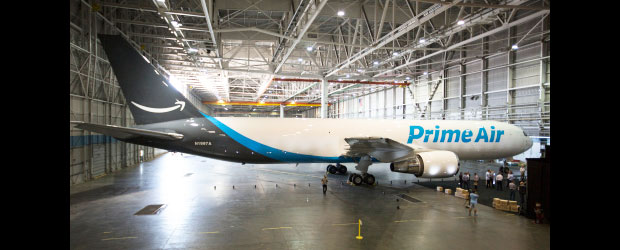Amazon last week unveiled its first Prime Air plane during the Boeing Seafair Air Show in Seattle. The company has undertaken an ambitious effort to gain control of its massive distribution network for delivery of goods to its retail customers.
The plane, dubbed “Amazon One,” is a Boeing 767-300 operated by Atlas Air. Atlas and ATSG have partnered with Amazon to fly a total of 40 cargo planes under separate lease agreements. Amazon currently has a total of 11 cargo planes in service on flights in the U.S., with additional aircraft schedule for introduction. Amazon One is the first to carry the “Prime Air” brand.
The fleet will provide additional capacity to serve Prime members with one- and two-day package delivery in the U.S., said Dave Clark, senior vice president of worldwide operations.
“Adding capacity for Prime members by developing a dedicated air cargo network ensures there is enough available capacity to provide customers with great selection, low prices and incredible shipping speeds for years to come,” he added.
Prime Air
Amazon wants to expand its control over package distribution in order to reduce costs and improve customer satisfaction.
The company over the past year has taken several steps to increase its capacity. It introduced Amazon Flex, a program that lets people sign up for package delivery gigs. It expanded its trucking capacity with a dedicated network of 4,000 trailers and 125 fulfillment centers, as well as 20 sorting centers to help route packages to the proper destination.
Amazon’s planes will be used to provide additional capacity beyond that afforded by its existing package delivery partners, Amazon spokesperson Amanda Ip told the E-Commerce Times.
The company has relied on UPS, FedEx and the U.S. Postal Service for package delivery. However, in previous holiday periods some of those operations have been overwhelmed by the demands Amazon placed on their distribution networks.
Partners Still Critical
UPS will continue to provide package delivery services for a variety of retail customers, including Amazon, said spokesperson Matthew O’Connor.
“It’s not unusual for a large shipper to make decisions about outsourcing or insourcing different parts of their business,” he told the E-Commerce Times. “UPS is growing its profitable business while increasing the value proposition we offer to our customers.”
During the second quarter, UPS deliveries to residential addresses grew at a pace five times the growth of deliveries to business addresses, he said — a clear reflection of the growing use of package delivery by online retailers.
“UPS expects to continue to increase its proportion of residential deliveries made for its broad base of online retailers, as consumers in major global markets increasingly embrace online shopping,” said O’Connor. “Amazon is a good customer and we value our mutually beneficial relationship.”
Despite its efforts, “Amazon has virtually no control over its last mile [distribution] as we sit here today,” noted Charlie O’Shea, lead retail analyst at Moody’s. “Virtually almost all of its last mile capability is out of its control.”
While Amazon is fighting to pare down nearly US$5 billion in costs that it must absorb to deliver packages to its customers, the vast majority of retail spending, more than 90 percent of it, is still done through traditional brick-and-mortar retailers, he told the E-Commerce Times.
Retailers like Walmart and warehouse clubs like Costco still have an enormous advantage, according to O’Shea, because traditional retail stores remain great places, from a distribution standpoint, to let customers shop and pick up goods.
Certain categories of goods, including groceries, remain much better served through brick-and -mortar retail than e-commerce, he pointed out.
“There’s been this misconception that brick-and- mortar retailers have failed online,” O’Shea remarked. “They haven’t even started.”























































Social Media
See all Social Media